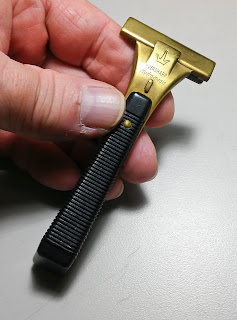The injector razor, so named after the method of loading the blade, was the brain-child of Jacob Schick, a grunt who served during the turn of the century (not this last one...the one before). Blades are stored inside a (then brass, and later aluminum) case, fitted with a "key" which was stuck into a slot in the razor. A loading tab was pulled back, then slid forward, forcing the bade into the razor's head. Schick supposedly got the idea from the way rifles were charged. Nifty, huh? These razors and associated injectors were marketed and sold through Schick's Magazine Repeating Razor Company, founded on 1926. Col. Schick sold this company in order to raise capital for some stupid electric razor nonsense. But I digress...
There are several manufacturers who made injector razors, but Schick is probably the best known. The first Schick to use the injector method was the "D" Type (1935), which was opened in an odd scissor-fashion for cleaning...
(Note: The "Type" designation is not a company-created idea, but was created by a third-party to facilitate identification.)
Next, from 1935-1945, came the "E" Type. Now, here's where it starts getting a bit confusing. There are different spring designs: flat with outward-facing tabs; round with inward facing tabs (these springs could be swiveled to the left in order to open the head for cleaning); fixed spring with non-opening head; the irregular striations on the guard bar were replaced with parallel lines; and the head was either textured or smooth gold-plated. Handles were of molded Bakelite, with no seam. The round rivet was marked "Schick Injector", and inside of head had a single patent number and "Others Pending".
Schick "E2" head
From 1940-1941, The "F" Type was produced, having an alloy handle which also formed the guard bar, and an integral cap and spring...
Eversharp bought the rights to the Schick injector in 1946; while the head remained the same (with the exception of some razors having "Eversharp" replacing "Schick" on the rivet), the handle was changed to molded plastic of various colors and an obvious lengthwise seam.
These were produced 1946-1955, and can be easily identified by the two patent numbers stamped inside the head. The "G" Type, as these are known, are somewhat milder than their predecessor, but this is another one of those "YMMV" things.
1947-53 saw the "Fashion Razor" ("H" Type) for the ladies, basically a small plastic box the took the injector razor...
1955 saw the first major change in 20 years with the "I" Type. The "I2" Type was known as the "Hydro-Magic", and was fitted with a lever which loosened the head for ease in cleaning.
The following years, up to 1980, saw little change with the exception of the handle becoming longer and slimmer...here's an "L" Type...
...although the code inside the head is stamped "M45"...
The "M" Type was the adjustable model...
In 1980, Schick (oops, I mean Warner Lambert, since Eversharp sold the rights to them in 1969), came out with the "N" Type with a redesigned "T"-shaped head...
...and the final model, the "O" Type, was produced for foreign markets, most notably Japan (where Schick injectors enjoy a strong following)...
So much for Schicks.Gillette also produced an injector razor...
...and another for twin blades...
Don't let the "Trac II" name confuse you with the "Trac II" cartridge razor. Different beast altogether.
PAL produced both a fixed and adjustable injector, as did Personna (fixed only). There are also newer injector razors on the market, but as they aren't vintage, they have no business here.
Injectors are just as capable of performing as well as double-edge razors, and the new Chinese-made Schick blades (known as "Chicks") are smooth, sharp, and comfortable. Single-edge blades can easily be found online, but the twin-edge are both scarce and expensive. I was fortunate enough to score a NOS, unopened box of Personna Twins off that auction site (as well as a good supply of Williams pucks)...

Note: All single-edge injector blades will fit any of these vintage razors. The twin blades, however, will ONLY work in razors made AFTER 1961, and NOT in the PAL adjustable razors or those razors fitted with a rinsing lever. There is a very real chance the blade will get stuck due to its being thicker than the single blade. Now, I tried one in my Schick E2, since the head will open, and it seemed to fit. I haven't tried it, though. So, there is my disclaimer. Proceed at your own risk.
Edit: I have since tried a twin blade in my E2, and it performed marvelously. I removed the blade after use to reduce any chance the (slightly) thicker twin could deform the head. I inserted the dummy blade, and found no ill effects. Second shave with the twin was equally great. E2 only, boys & girls, since the head can be opened to insert the blade by hand. I did not attempt to use the injector.
(Note: There were earlier injector razors; these had a mechanism built into the razor itself to load the blade, instead of using a separate injector. These were the Type A, B, and C repeating razors.)
Type A
Type B
Type C
The head would swivel parallel with the handle, and loaded by pulling the opposite end, then pushing a new blade into the head. The head is then swiveled perpendicular to the handle, ready to shave. I've read that there are no nubs ("stops") in the razor's head, like later injectors, and some re-positioning of the blade might have to be done with a toothpick in order to get it in the proper position. Still, worthy of note and would be an interesting addition to any collection.)

















